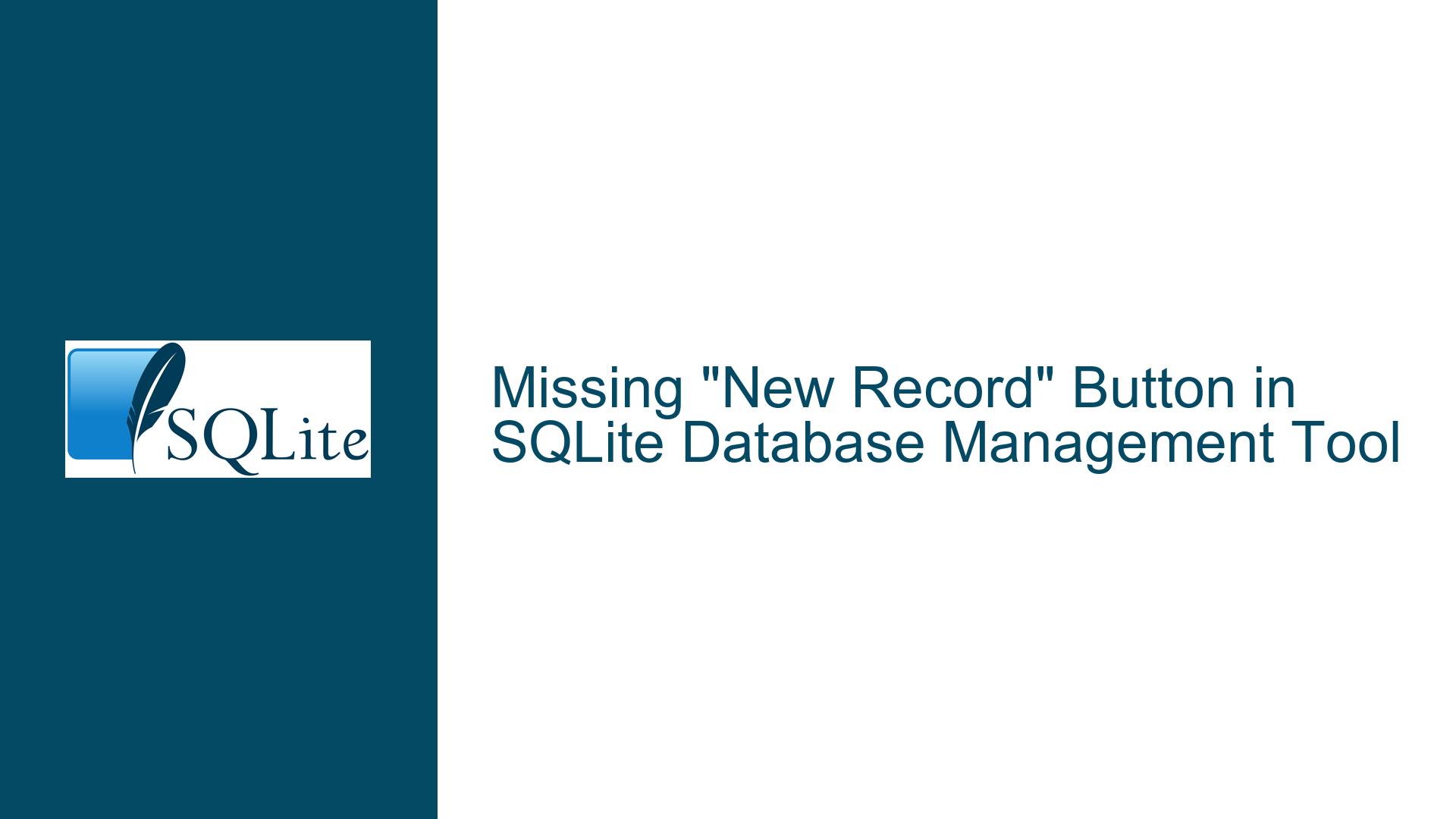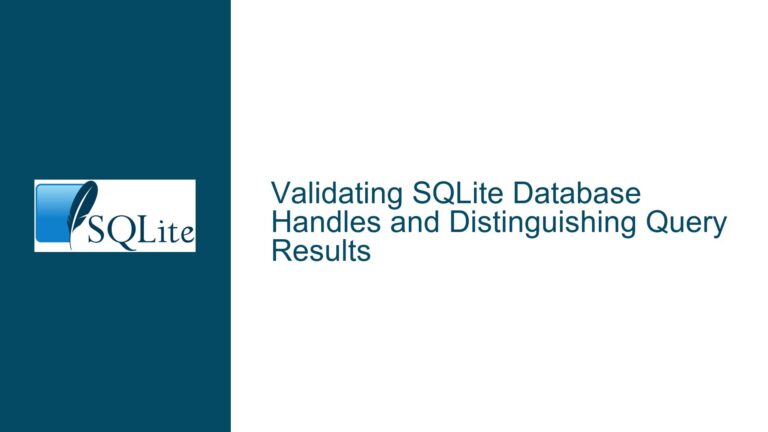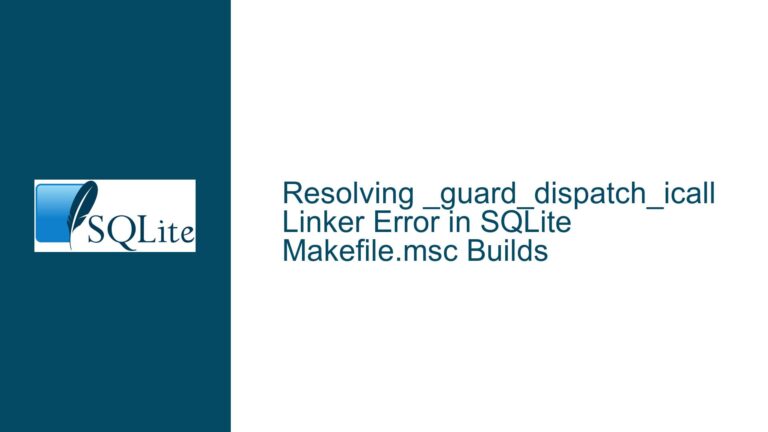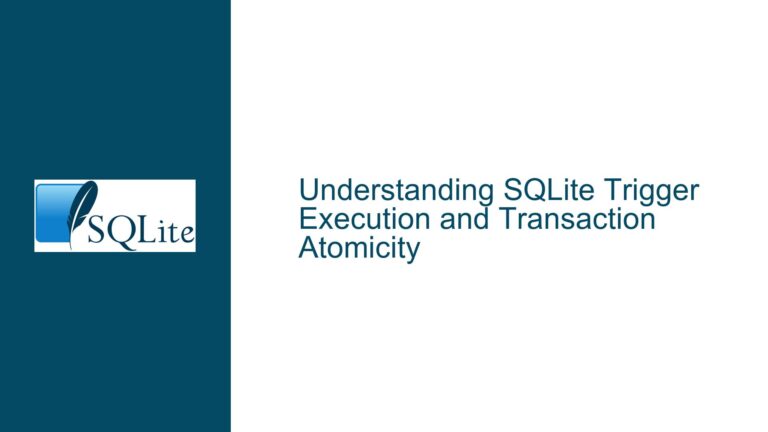Missing “New Record” Button in SQLite Database Management Tool
Understanding the Absence of a "New Record" Button in SQLite Database Tools
SQLite, as a lightweight, serverless, and self-contained database engine, does not inherently include a graphical user interface (GUI) or any form of buttons for database management. The confusion often arises when users interact with SQLite through third-party tools or database management utilities, such as DB Browser for SQLite, which provide a GUI for easier interaction with SQLite databases. The absence of a "New Record" button in such tools can be perplexing, especially for beginners who are transitioning from other database systems that might offer more integrated GUI features. This issue is not a limitation of SQLite itself but rather a characteristic of the tools used to interact with it. Understanding this distinction is crucial for effectively troubleshooting and resolving the problem.
Exploring the Role of Third-Party Tools in SQLite Database Management
Third-party tools like DB Browser for SQLite are designed to simplify the process of managing SQLite databases by providing a user-friendly interface. These tools often include features such as table creation, data entry, and query execution through a GUI. However, the functionality and interface of these tools can vary significantly, and not all tools provide a "New Record" button for adding data to tables. Instead, they may require users to manually write and execute SQL queries, such as the INSERT statement, to add new records. This approach aligns more closely with the nature of SQLite, which is fundamentally a command-line driven database engine. The reliance on SQL queries rather than GUI buttons is a design choice that emphasizes the importance of understanding SQL syntax and the underlying database operations.
Navigating the SQL Input Tab for Data Entry in DB Browser for SQLite
In the context of DB Browser for SQLite, the absence of a "New Record" button does not mean that adding records is impossible. Instead, users are expected to utilize the SQL input tab, where they can write and execute SQL queries directly. This method provides greater flexibility and control over the data entry process, allowing users to insert multiple records, specify column values, and handle complex data types with precision. For example, to add a new record to a table named employees, one would write an INSERT query like the following: INSERT INTO employees (name, position, salary) VALUES ('John Doe', 'Software Engineer', 75000);. Executing this query through the SQL input tab will add the specified record to the employees table. This approach not only resolves the immediate issue of adding records but also reinforces the user’s understanding of SQL and its role in database management.
Leveraging SQLite Documentation for Effective Data Management
To further assist users in overcoming the challenge of adding records without a "New Record" button, it is essential to refer to the official SQLite documentation. The documentation provides comprehensive guidance on the INSERT statement, including syntax, usage examples, and best practices. By familiarizing themselves with this resource, users can gain a deeper understanding of how to construct effective SQL queries for data entry. Additionally, the documentation covers related topics such as data types, constraints, and transaction management, which are critical for maintaining data integrity and optimizing database performance. Utilizing the SQLite documentation as a reference not only addresses the immediate issue but also equips users with the knowledge needed to handle more complex database tasks in the future.
Addressing Common Misconceptions About SQLite and GUI Tools
A common misconception among new SQLite users is that the database engine itself should provide a GUI with buttons for common tasks like adding records. This misunderstanding often stems from prior experience with other database systems that offer more integrated GUI features. However, SQLite’s design philosophy emphasizes simplicity, efficiency, and portability, which means it does not include a built-in GUI. Instead, SQLite relies on third-party tools to provide these features, and the functionality of these tools can vary widely. Recognizing this distinction is crucial for effectively troubleshooting issues related to database management and for selecting the appropriate tools for specific tasks. By understanding the roles and limitations of both SQLite and the tools used to interact with it, users can avoid common pitfalls and make more informed decisions when managing their databases.
Implementing Best Practices for SQLite Database Management
To ensure a smooth and efficient experience when working with SQLite, it is important to adopt best practices for database management. These practices include regularly backing up the database, using transactions to maintain data integrity, and optimizing queries for performance. Additionally, users should familiarize themselves with the SQL syntax and the specific features of the tools they are using. For example, in DB Browser for SQLite, users should become proficient in using the SQL input tab for executing queries and the browse data tab for viewing and editing records. By following these best practices, users can minimize the likelihood of encountering issues like the missing "New Record" button and can more effectively manage their SQLite databases.
Exploring Alternative SQLite Management Tools
While DB Browser for SQLite is a popular choice for managing SQLite databases, it is not the only option available. There are several other tools that provide different features and interfaces, some of which may include a "New Record" button or similar functionality. For example, SQLiteStudio and DBeaver are two alternative tools that offer more advanced GUI features, including the ability to add records through a form-based interface. Exploring these alternatives can provide users with additional options for managing their databases and can help them find a tool that better suits their needs and preferences. However, it is important to note that even with these tools, a solid understanding of SQL and database concepts is still essential for effective database management.
Enhancing SQL Skills for Effective Database Management
Ultimately, the key to resolving the issue of the missing "New Record" button lies in enhancing one’s SQL skills. SQLite, like other relational database systems, relies heavily on SQL for data manipulation and management. By becoming proficient in SQL, users can perform a wide range of tasks, from simple data entry to complex querying and reporting, without relying on GUI buttons or other interface elements. There are numerous resources available for learning SQL, including online tutorials, courses, and books, as well as the official SQLite documentation. Investing time in learning SQL not only addresses the immediate issue but also provides a strong foundation for future database management tasks and challenges.
Conclusion: Embracing the Command-Line Nature of SQLite
In conclusion, the absence of a "New Record" button in SQLite database management tools is not a limitation of SQLite itself but rather a reflection of its command-line driven nature. By understanding this distinction and leveraging the appropriate tools and resources, users can effectively manage their SQLite databases and perform tasks such as adding records with confidence. Whether through the SQL input tab in DB Browser for SQLite or by exploring alternative tools, the key to success lies in developing a strong understanding of SQL and embracing the command-line approach that SQLite embodies. With this knowledge and approach, users can overcome the challenges of database management and unlock the full potential of SQLite for their projects and applications.






